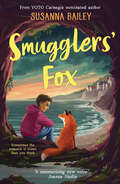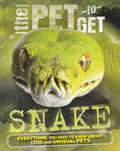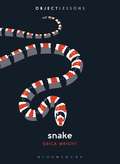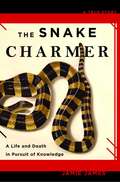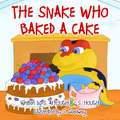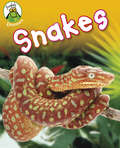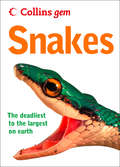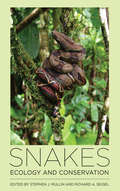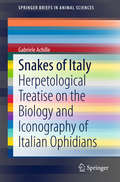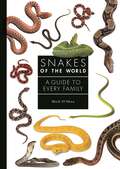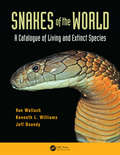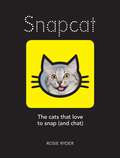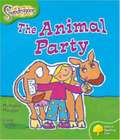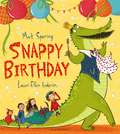- Table View
- List View
The Smug Pug (Pooch Parlour #3)
by Anna WilsonThere's a new kid in Crumbly-under-Edge. Smug the pug is clever, funny and full of surprises. And his owner, Tallulah Foghorn, is just as fantastic. PIppa Peppercorn has fallen head over heels for the devastating duo. Dash the dachshund, on the other paw, is not sure. He thinks Smug lives up to his name, and Tallulah is nuttier than one of Mrs Fudge's fruitcakes...
Smugglers’ Fox
by Susanna BaileyA spellbinding and poignant new adventure from Susanna Bailey, the critically acclaimed author of Snow Foal. Perfect for fans of Jacqueline Wilson and Hannah Gold
Snail (Large Print)
by RnibThis is a picture of a garden snail seen from the side and facing to the left. There is a locator dot shown, which will be at the top left of the page when the image is the right way up. Just down the page, there is a silhouette of the snail at approximately real size. On the left of the page is the snail's head, which has a small mouth and two long stalks with eyes at the ends. To the right is the body of the snail. Up the page from this is its shell. This grows in the form of a spiral; you can follow this round, starting from right of the head, to the centre of the shell. At the very bottom of the image is a trail of mucus (slime), which has been left by the snail. It is used to help it to slide easily over rough surfaces.
Snail (UEB Contracted)
by RnibThis is a picture of a garden snail seen from the side and facing to the left. There is a locator dot shown, which will be at the top left of the page when the image is the right way up. Just down the page, there is a silhouette of the snail at approximately real size. On the left of the page is the snail's head, which has a small mouth and two long stalks with eyes at the ends. To the right is the body of the snail. Up the page from this is its shell. This grows in the form of a spiral; you can follow this round, starting from right of the head, to the centre of the shell. At the very bottom of the image is a trail of mucus (slime), which has been left by the snail. It is used to help it to slide easily over rough surfaces.
Snail (UEB uncontracted)
by Rnib BookshareThis is a picture of a garden snail seen from the side and facing to the left. There is a locator dot shown, which will be at the top left of the page when the image is the right way up. Just down the page, there is a silhouette of the snail at approximately real size. On the left of the page is the snail's head, which has a small mouth and two long stalks with eyes at the ends. To the right is the body of the snail. Up the page from this is its shell. This grows in the form of a spiral; you can follow this round, starting from right of the head, to the centre of the shell. At the very bottom of the image is a trail of mucus (slime), which has been left by the snail. It is used to help it to slide easily over rough surfaces.
Snail (UEB Uncontracted)
by RnibThis is a picture of a garden snail seen from the side and facing to the left. There is a locator dot shown, which will be at the top left of the page when the image is the right way up. Just down the page, there is a silhouette of the snail at approximately real size. On the left of the page is the snail's head, which has a small mouth and two long stalks with eyes at the ends. To the right is the body of the snail. Up the page from this is its shell. This grows in the form of a spiral; you can follow this round, starting from right of the head, to the centre of the shell. At the very bottom of the image is a trail of mucus (slime), which has been left by the snail. It is used to help it to slide easily over rough surfaces.
Snake: Snake (The Pet to Get #3)
by Rob ColsonFind out what snakes are like as pets and what care they will need. Information is provided on housing, feeding and grooming and other essential elements of pet care. Learn all about snakes with advice from how to choose the right breed and find the right cage, to keeping your ferret happy and healthy. Also included are amazing fact files about specific species. Fantastic photographs bring the animals to life!
Snake (Object Lessons)
by Erica WrightObject Lessons is a series of short, beautifully designed books about the hidden lives of ordinary things. Feared and worshiped in equal measure, snakes have captured the imagination of poets, painters, and philosophers for centuries. From Ice Age cave drawings to Snakes on a Plane, this creature continues to enthrall the public. But what harm has been caused by our mythologizing? While considering the dangers of stigma, Erica Wright moves from art and pop culture to religion, fetish, and ecologic disaster. This book considers how the snake has become more symbol than animal, a metaphor for how we treat whatever scares us the most, whether or not our panic is justified.Object Lessons is published in partnership with an essay series in the The Atlantic.
Snake (Object Lessons)
by Erica WrightObject Lessons is a series of short, beautifully designed books about the hidden lives of ordinary things. Feared and worshiped in equal measure, snakes have captured the imagination of poets, painters, and philosophers for centuries. From Ice Age cave drawings to Snakes on a Plane, this creature continues to enthrall the public. But what harm has been caused by our mythologizing? While considering the dangers of stigma, Erica Wright moves from art and pop culture to religion, fetish, and ecologic disaster. This book considers how the snake has become more symbol than animal, a metaphor for how we treat whatever scares us the most, whether or not our panic is justified.Object Lessons is published in partnership with an essay series in the The Atlantic.
The Snake and the Salamander: Reptiles and Amphibians from Maine to Virginia
by Alvin R. BreischIn the best tradition of natural history writing and art, The Snake and the Salamander explores the diverse collection of reptiles and amphibians that inhabit the northeastern quadrant of the United States. Covering 13 states that run from Maine to Virginia, author Alvin R. Breisch and artist Matt Patterson showcase the lives of 83 species of snakes, lizards, turtles, frogs, and salamanders. These intriguing animals are organized by habitat and type, from forest to grassland to bogs to big waters, and revealed through a combination of Breisch’s engaging prose and Patterson’s original color illustrations. Breisch’s guided tour combines historical notes and conservation issues with lessons on genetics, evolution, habitats, life histories, and more. Discover how careful attention to frog calls coupled with DNA analysis led to the discovery of a new species of frog in New York City, why evolutionary adaptations made the Eastern Ratsnake a superb climber, and the surprising fact that Spiny Softshell turtles actually sprint on land to retreat from predators. Breisch also tells the odd tale of the Green Frog and the Smooth Greensnake, two "green species" that do not actually have any green pigment in their skin. Every species has a story to tellâ€�one that will keep the reader wanting to learn more.The breadth of herpetofauna in the area will surprise many readers: more than 8% of the world’s salamanders and 11% of all turtle species live in the region. Beyond numbers, however, lie aesthetics. The surprising colors and fascinating lifestyles of the reptile and amphibian species in this book will mesmerize readers young and old.
The Snake Charmer: A Life and Death in Pursuit of Knowledge
by Jamie JamesAlthough it was still too dark to see well, Joe absentmindedly thrust his right hand into the sack to extract the specimen and have a look. Immediately, he winced with pain and yanked out his hand. A tiny black-and-white banded snake, less than ten inches long, was dangling limply from his middle finger, its fangs still sunk into his flesh. In the fall of 2001, deep in the jungle of Burma, a team of scientists is searching for rare snakes. They are led by Dr. Joe Slowinski, at forty already one of the most brilliant biologists of our time. It is the most ambitious scientific expedition ever mounted into this remote region, venturing into the foothills of the Himalayas. The bold undertaking is brought to a dramatic halt by the bite of the many-banded krait, the deadliest serpent in Asia. In the moment he pulled his hand from the specimen bag and saw the krait, Joe knew that his life was in grave and imminent peril. Thus began one of the most remarkable wilderness rescue attempts of modern times, as Joe's teammates kept him alive for thirty hours by mouth-to-mouth respiration, waiting for a rescue that never came. A daredevil obsessed with venomous snakes since his youth, Slowinski was a modern-day adventurer who rose quickly to the top of his field, discovering many previously unidentified snake species in his brief yet exhilarating career. The Snake Charmer is at once brilliant biography and exotic travel literature, blended with an accessible introduction to the bizarre, fascinating-and sometimes controversial-world of snake science. The narrative transports the reader into primeval wilderness, from the Everglades to Peru to Burma, in search of rattlesnakes and boa constrictors, kraits and cobras. Joe Slowinski's career was fast and exciting, his tragic final expedition a pulse-pounding struggle between man and nature. In The Snake Charmer, renowned journalist and author Jamie James captures the life and death of this charismatic, endlessly fascinating man. Exhaustively researched in interviews with Slowinski's colleagues and family, and the author's own trek into the wilds of Burma, this is narrative nonfiction in the tradition of Into the Wild and The Perfect Storm.
The Snake Who Baked A Cake
by S. Afrough S. HoughThis is the story of a Snake who decided to bake a big cake.
Snakes: Learners: Snakes (Froglets: Learners #5)
by Annabelle LynchFind out all about slithering snakes, from tiny thread snakes to enormous boa constrictors.Leapfrog Learners offer fun facts in accessible text, perfect for building reading confidence.
Snakes (Collins Gem)
by Chris MattisonAn easy-to-use and authoritative guide to over 220 species of snake from around the world, each entry specially selected to show the diversity of size, shape and colour of these respected creatures.
Snakes: Ecology and Conservation
Destruction of habitat due to urban sprawl, pollution, and deforestation has caused population declines or even extinction of many of the world's approximately 2,600 snake species. Furthermore, misconceptions about snakes have made them among the most persecuted of all animals, despite the fact that less than a quarter of all species are venomous and most species are beneficial because they control rodent pests. It has become increasingly urgent, therefore, to develop viable conservation strategies for snakes and to investigate their importance as monitors of ecosystem health and indicators of habitat sustainability.In the first book on snakes written with a focus on conservation, editors Stephen J. Mullin and Richard A. Seigel bring together leading herpetologists to review and synthesize the ecology, conservation, and management of snakes worldwide. These experts report on advances in current research and summarize the primary literature, presenting the most important concepts and techniques in snake ecology and conservation. The common thread of conservation unites the twelve chapters, each of which addresses a major subdiscipline within snake ecology. Applied topics such as methods and modeling and strategies such as captive rearing and translocation are also covered. Each chapter provides an essential framework and indicates specific directions for future research, making this a critical reference for anyone interested in vertebrate conservation generally or for anyone implementing conservation and management policies concerning snake populations.Contributors: Omar Attum, Indiana University Southeast; Steven J. Beaupre, University of Arkansas; Xavier Bonnet, Centre National de la Recherche Scientifique; Frank T. Burbrink, College of Staten Island-The City University of New York; Gordon M. Burghardt, University of Tennessee; Todd A. Castoe, University of Colorado; David Chiszar, University of Colorado; Michael E. Dorcas, Davidson College; Lara E. Douglas, University of Arkansas; Christopher L. Jenkins, Project Orianne, Ltd.; Glenn Johnson, State University of New York at Potsdam; Michael Hutchins, The Wildlife Society; Richard B. King, Northern Illinois University; Bruce A. Kingsbury, Indiana University-Purdue University Fort Wayne; Thomas Madsen, University of Wollongong; Stephen J. Mullin, Eastern Illinois University; James B. Murphy, National Zoological Park; Charles R. Peterson, Idaho State University; Kent A. Prior, Parks Canada; Richard A. Seigel, Towson University; Richard Shine, University of Sydney; Kevin T. Shoemaker, College of Environmental Science and Forestry, State University of New York; Patrick J. Weatherhead, University of Illinois; John D. Willson, University of Georgia
Snakes of Central and Western Africa
by Jean-Philippe Chippaux Katherine JacksonNobody knows exactly how many snake species live in the biodiversity hotspots of Western and Central Africa. While field guides abound that make mammals, birds, and even insects identifiable for residents, travelers, and scientists, half a continent's herpetological richness has remained shrouded in mystery. In a region where nearly 30,000 people die from snake bites every year, even dire medical necessity has been an insufficient inducement for researchers to take on the daunting task of assembling an authoritative list of extant species, let alone a full descriptive record to aid in identification, the essential first step to administering an effective antivenin. The reptiles of Central Africa, particularly, are the most poorly studied in the world, despite their crucial role in the survival of threatened ecosystems.With Snakes of Central and Western Africa, Jean-Philippe Chippaux and Kate Jackson have created a game changer. The result of years of field research and systematic study in the world's leading museums, this book compiles for the first time a comprehensive guide to the region's snakes. Covering a vast swath of the continent, ranging from Mauritania in the northwest to Rwanda in the east and Angola in the south, Chippaux and Jackson provide detailed accounts for the more than 200 species of snakes that inhabit the region. The first part of the book is devoted to the taxonomic characters used for identifying snakes. The authors deal with the evolution and biogeography of African snakes as well as epidemiological and clinical aspects of snakebite. The remaining chapters are organized phylogenetically, following the latest consensus on evolutionary patterns of major snake lineages in sub-Saharan Africa. Species identification is facilitated by simple and accessible dichotomous keys and detailed descriptions of morphological characteristics, complemented by numerous drawings, photos, and distribution maps. Invaluable information on taxonomy and natural history is also included. The book concludes with a comprehensive index and a list of nearly 600 references. Snakes of Central and Western Africa illuminates a previously little-known part of the natural world, provides vital information that could save many lives, and will make an excellent addition to any herpetology library.
Snakes of Central and Western Africa
by Jean-Philippe Chippaux Katherine JacksonNobody knows exactly how many snake species live in the biodiversity hotspots of Western and Central Africa. While field guides abound that make mammals, birds, and even insects identifiable for residents, travelers, and scientists, half a continent's herpetological richness has remained shrouded in mystery. In a region where nearly 30,000 people die from snake bites every year, even dire medical necessity has been an insufficient inducement for researchers to take on the daunting task of assembling an authoritative list of extant species, let alone a full descriptive record to aid in identification, the essential first step to administering an effective antivenin. The reptiles of Central Africa, particularly, are the most poorly studied in the world, despite their crucial role in the survival of threatened ecosystems.With Snakes of Central and Western Africa, Jean-Philippe Chippaux and Kate Jackson have created a game changer. The result of years of field research and systematic study in the world's leading museums, this book compiles for the first time a comprehensive guide to the region's snakes. Covering a vast swath of the continent, ranging from Mauritania in the northwest to Rwanda in the east and Angola in the south, Chippaux and Jackson provide detailed accounts for the more than 200 species of snakes that inhabit the region. The first part of the book is devoted to the taxonomic characters used for identifying snakes. The authors deal with the evolution and biogeography of African snakes as well as epidemiological and clinical aspects of snakebite. The remaining chapters are organized phylogenetically, following the latest consensus on evolutionary patterns of major snake lineages in sub-Saharan Africa. Species identification is facilitated by simple and accessible dichotomous keys and detailed descriptions of morphological characteristics, complemented by numerous drawings, photos, and distribution maps. Invaluable information on taxonomy and natural history is also included. The book concludes with a comprehensive index and a list of nearly 600 references. Snakes of Central and Western Africa illuminates a previously little-known part of the natural world, provides vital information that could save many lives, and will make an excellent addition to any herpetology library.
Snakes of Italy: Herpetological Treatise on the Biology and Iconography of Italian Ophidians (SpringerBriefs in Animal Sciences)
by Gabriele AchilleThis book offers a comprehensive review of the biology of snakes, focusing on Italian species. The snakes of Italy belong to the two families Colubridae and Viperidae, and for each species the systematic classification and chorology including distribution maps are presented. Furthermore, readers will learn how to carry out field studies, how to handle snakes and how to photograph them. The book concludes with a chapter on the iconography of historical Italian snakes and their importance in popular science, and one on myths and legends. This SpringerBriefs volume will appeal to herpetologists and technical staff. The section on iconography may also be of interest to museum staff.
Snakes of the World: A Supplement
by Jeff BoundySnakes of the World: A Catalogue of Living and Extinct Species, published in 2014, was the first catalogue of its kind and covered all living and fossil snakes described between 1758 and 2012. This new volume will be a supplement to this important herpetological reference and will include new published data on snakes named and recognized since 2012. Key Features Supplements and updates Wallach et al. – Snakes of the World – the only work to cover all living snakes in the world. Includes updates for fossil snakes named since the publication of Wallach et al. Summarizes the systematic snake literature published since the appearance of Wallach et al. Genera and species are listed alphabetically for ease of reference. Related Titles Wallach, V., K. L. Williams, and J. Boundy. Snakes of the World: A Catalogue of Living and Extinct Species (ISBN 978-1-138-03400-6) Aldridge, R. D. and D. M. Sever, eds. Reproductive Biology and Phylogeny of Snakes (ISBN 978-1-57808-701-3) Caldwell, M. W. The Origin of Snakes: Morphology and the Fossil Record (ISBN 978-1-4822-5134-0)
Snakes of the World: A Supplement
by Jeff BoundySnakes of the World: A Catalogue of Living and Extinct Species, published in 2014, was the first catalogue of its kind and covered all living and fossil snakes described between 1758 and 2012. This new volume will be a supplement to this important herpetological reference and will include new published data on snakes named and recognized since 2012. Key Features Supplements and updates Wallach et al. – Snakes of the World – the only work to cover all living snakes in the world. Includes updates for fossil snakes named since the publication of Wallach et al. Summarizes the systematic snake literature published since the appearance of Wallach et al. Genera and species are listed alphabetically for ease of reference. Related Titles Wallach, V., K. L. Williams, and J. Boundy. Snakes of the World: A Catalogue of Living and Extinct Species (ISBN 978-1-138-03400-6) Aldridge, R. D. and D. M. Sever, eds. Reproductive Biology and Phylogeny of Snakes (ISBN 978-1-57808-701-3) Caldwell, M. W. The Origin of Snakes: Morphology and the Fossil Record (ISBN 978-1-4822-5134-0)
Snakes of the World: A Guide to Every Family (A Guide to Every Family #6)
by Mark O'SheaA gorgeously illustrated guide to the incredible diversity of snakes around the worldSnakes are found on every continent except Antarctica and have evolved to occupy a vast range of habitats, from mountains to oceans and deserts to rain forests. Snakes of the World explores their extraordinary diversity, with an in-depth introduction covering anatomy, behavior, habitats, reproduction, conservation, and other essential topics. This expert guide also includes profiles of some of the approximately 4,000 species of snakes, featuring examples from every family and subfamily.Each family profile highlights the remarkable appearance, characteristics, and lifestyle of notable snake species. Covering how snakes use venom or constriction to subdue their prey, how a snake’s appearance can aid camouflage or boast of its killing capacity, and how habitat destruction is jeopardizing the future of many species, Snakes of the World is an invaluable guide to these fascinating reptiles.Features more than 200 stunning color photographsPresents species profiles with a commentary, distribution map, and table of informationIncludes examples from every snake family and subfamily
Snakes of the World: A Catalogue of Living and Extinct Species
by Van Wallach Kenneth L. Williams Jeff BoundySnakes of the World: A Catalogue of Living and Extinct Species-the first catalogue of its kind-covers all living and fossil snakes described between 1758 and 2012, comprising 3,509 living and 274 extinct species allocated to 539 living and 112 extinct genera. Also included are 54 genera and 302 species that are dubious or invalid, resulting in reco
Snapcat: The Cats Who Love to Snap (and Chat)
by Rosie RyderJoin the cats who snap, and discover the candid stories of their daily lives. These cool kitties have a lot to say, and whether it’s with a cheeky filter or a sassy caption, they say it with style. You’ll see your fur-miliar friends through a whole new lens.
Snappy Birthday
by Laura Ellen Anderson Mark SperringOne day an invitation Came to number 24. It was from a next-door neighbour Who they'd never met before. The children can't wait - a birthday party? What fun! But their next-door neighbour is not all he seems. For starters, there's his large snout and very sharp teeth. Not to mention his scaly skin . . . Yes, there's no two ways about it, he's definitely a CROCODILE. Erm, crocodiles don't eat children, do they? A riotous romp of a picture book, superbly written by Mark Sperring and brilliantly illustrated by Laura Anderson. Snappy Birthday is the perfect present for any child - whether it's their birthday, or not!

